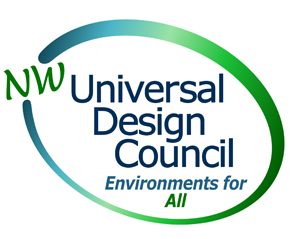Walk-, Stroll- & Roll-Ability: Designing a Pedestrian Network for All

Have you ever walked down a street and run into overgrowth; construction closure; no sidewalk, path, or ramp; no place to rest; so much traffic that you can’t cross the street; or some other barrier? Can you get everywhere you need to go without a car—to the grocery store, to restaurants, or to the bus?
What if you require a wheelchair or a walker? What if you have limited eyesight? Would you be able to traverse your neighborhood? Is it sufficient for you to live comfortably and grow old in your current home?

The Northwest Universal Design Council hosts quarterly presentations on issues related to design of the built and social environment. Learn more at www.environmentsforall.org.
These are some of the questions that prompted the Northwest Universal Design Council to plan “Walk-, Stroll- & Roll-Ability: Designing a Pedestrian Network for All”—a presentation on January 14 by Seattle Department of Transportation ADA coordinator Mike Shaw and design and construction engineers John Ricardi and Eugene Pike (see details below). They will discuss challenges and solutions in developing a pedestrian network that works for all—sidewalks, curb ramps, street crossings, accessible pedestrian signals, transit access, and more—from a Universal Design perspective.
Universal Design guidelines include:
- Equitable Use—The design is useful and marketable to people with diverse abilities.
- Flexibility in Use—The design accommodates a wide range of individual preferences and abilities.
- Simple and Intuitive Use—Use of the design is easy to understand, regardless of the user’s experience, knowledge, language skills, or current concentration level.
- Perceptible Information—The design communicates necessary information effectively to the user, regardless of ambient conditions or the user’s sensory abilities.
- Tolerance for Error—The design minimizes hazards and the adverse consequences of accidental or unintended actions.
- Low Physical Effort—The design can be used efficiently and comfortably and with a minimum of fatigue.
- Size and Space for Approach and Use—Appropriate size and space is provided for approach, reach, manipulation, and use regardless of user’s body size, posture or mobility.
How would you apply these guidelines to the design of your pedestrian environment? Come to Walk-, Stroll- & Roll-Ability: Designing a Pedestrian Network for All for a rich discussion of these topics. This event takes place on Thursday, January 14, 2016 (10:00–11:30 a.m.) in Seattle Municipal Tower, Conference Room 4060 (700 Fifth Avenue, between Columbia & Cherry Streets in downtown Seattle).
This event is free and open to the public, co-sponsored by Aging and Disability Services, Feet First, King County Mobility Coalition, Seattle Commission for People with disAbilities, Seattle Department of Transportation, and the Seattle Human Services Department.
For directions to the Municipal Tower, visit https://bit.ly/1NQugTm.
If you require an accommodation in order to participate, e-mail info@environmentsforall.org at your earliest opportunity. For more information about Universal Design, visit www.environmentsforall.org.
![AgeWise King County [logo]](https://www.agewisekingcounty.org/wp-content/themes/agewisekingcounty/images/logo.png)